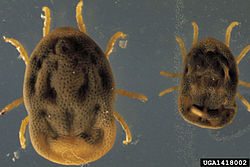| Otobius | |
|---|---|
 | |
| Otobius megnini | |
| Scientific classification | |
| Kingdom: | Animalia |
| Phylum: | Arthropoda |
| Subphylum: | Chelicerata |
| Class: | Arachnida |
| Order: | Ixodida |
| Family: | Argasidae |
| Genus: | Otobius N.Banks, 1912 [1] |
| Synonyms | |
| |
Otobius is a genus in the soft-bodied tick family, Argasidae. While similar to the genus Ornithodoros it is characterized by a vestigial hypostome in adults, despite being developed in nymphs, in addition to the absence of both eyes and hood.